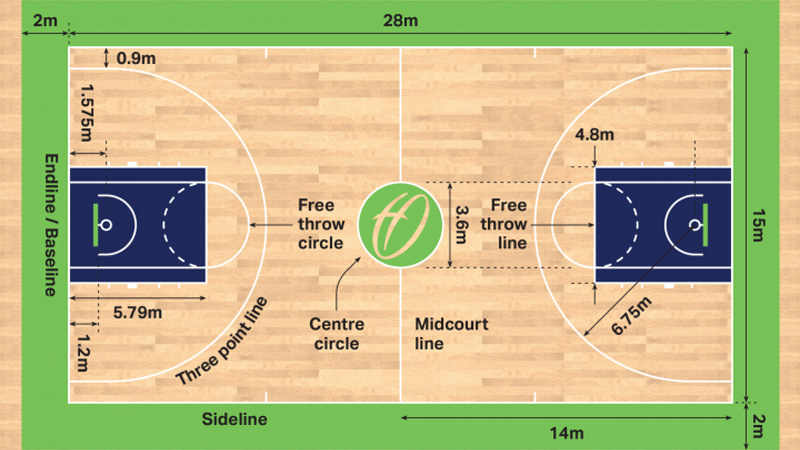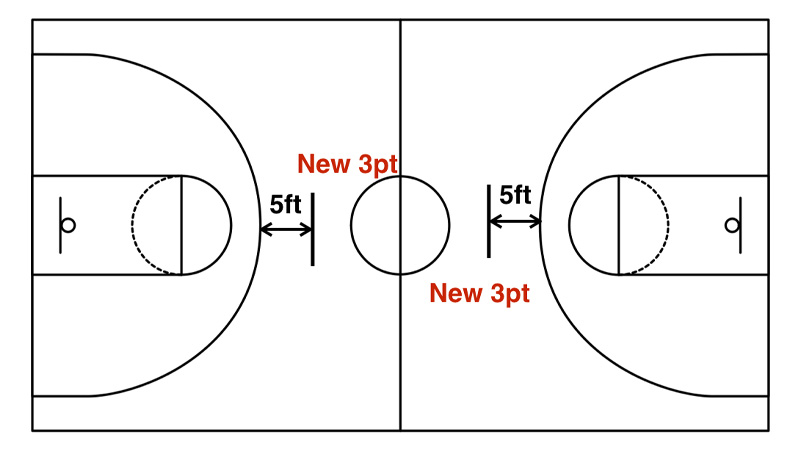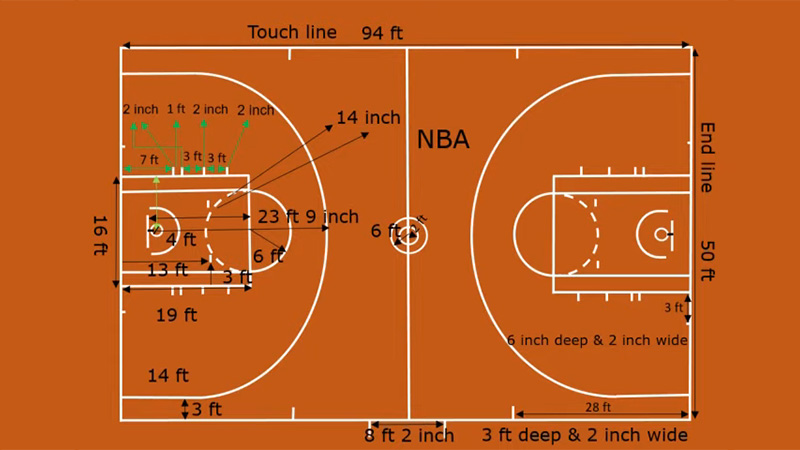The NBA, with its electrifying dunks, incredible plays, and fierce competition, is the pinnacle of professional basketball. Behind the mesmerizing on-court action lies a meticulously designed playing surface that adheres to strict regulations set by the league.
From the three-point line to the key, every inch of the NBA court is crafted to ensure fairness and consistency across all games.
In this blog post, we explore the dimensions of an NBA court, delving into the key features that define the playing surface where basketball legends are made. So, stay focused.
Is NBA Court Different Than Other Basketball Tournament Courts?
One of the significant differences between NBA courts and other basketball tournament courts lies in the level of standardization and consistency. The NBA has strict regulations governing the dimensions and features of its courts, ensuring that all teams play on an identical playing surface.
This standardization allows for fair and equitable competition, as players are familiar with the court’s dimensions, markings, and distances, regardless of the arena they play in.
Specific NBA Regulations
The NBA court follows specific regulations set forth by the league to maintain uniformity. These regulations dictate the size and placement of essential elements such as the three-point line, free-throw line, key, and restricted area.
The distances and measurements are carefully designed to enhance the game’s flow, encourage specific playing styles, and offer fair scoring opportunities.
Consistency in Playing Experience
NBA courts’ standardized design ensures that players and teams can expect a consistent playing experience, regardless of the arena they visit. Whether a team is playing on their home court or away, they will encounter the same court dimensions, three-point line distances, and key measurements.
This consistency allows players to focus on their skills and strategies without being affected by variations in court dimensions.
Variability in Other Tournament Courts
While the NBA court remains consistent across all teams, other basketball tournament courts may exhibit more variability. Different basketball organizations, associations, and levels of competition often have their own set of rules and regulations regarding court dimensions.
As a result, courts used in college basketball, high school tournaments, and international competitions may differ slightly from the standardized NBA court.
What Are the Dimensions of an NBA Court?

Source: harrodsport
The dimensions of an NBA court are not left to chance; they are carefully standardized by the league to uphold a level playing field and consistency across all games.
From the professional courts in bustling arenas to the local basketball courts in neighborhoods, these measurements are meticulously adhered to, ensuring that players and teams experience the same court size and features regardless of the venue.
Length: 94 feet (28.65 meters)
The length of an NBA court stretches an impressive 94 feet, equivalent to approximately 28.65 meters. This distance encompasses the entire playing area, from baseline to baseline.
The length allows for fast-paced transitions and exciting plays, providing players with ample room to showcase their speed and athleticism. The extra length also caters to the high-flying dunks and jaw-dropping alley-oops that have become synonymous with NBA basketball.
Width: 50 feet (15.24 meters)
An NBA court spans 50 feet in width, roughly 15.24 meters, measured between the two sidelines. The width accommodates all the on-court action, giving players enough space to navigate and execute strategic plays.
This width ensures that teams can effectively run their offenses and defenses without feeling cramped, fostering fluid ball movement and precise positioning.
Three-Point Line and Arc in the NBA Court

Source: 412sportsanalytics
The three-point line in the NBA is a game-changing element that adds excitement, drama, and a whole new dimension to the sport of basketball. Its implementation revolutionized the way the game is played and provided players with a golden opportunity to earn more points from a greater distance.
Let’s explore this iconic feature that sets the NBA court apart from other basketball tournament courts.
A Game-Changing Innovation
The introduction of the three-point line in the NBA during the 1979-1980 season was a game-changer. This innovation was the brainchild of the American Basketball Association (ABA) and was later adopted by the NBA to spice up the game and attract more fans.
The three-point line is a fundamental reason why the modern NBA features high-scoring games with spectacular long-range shooting displays.
Forming the Arc Around the Basket
The three-point line takes the form of a semicircle, gracefully curving around the basket. It begins at the baseline and extends outwards in an arc until it meets the straight lines at the top of the key and the corners of the court.
The arc, along with its precise measurements, is a critical aspect of ensuring that shots beyond this line are accurately counted as three-pointers.
Standard Distances from the Basket
In the NBA, the distance of the three-point line from the basket is set at 23.75 feet (7.24 meters) from the basket at the top of the key and 22 feet (6.7 meters) from the basket at the corners.
These specific measurements are designed to challenge players to shoot accurately from varying distances, testing their shooting skills and ability to read defensive setups.
Rewarding Long-Range Marksmanship
The three-point line has profoundly impacted the dynamics of basketball strategy. It has created a new breed of players known for their exceptional long-range shooting abilities, often referred to as “sharpshooters” or “three-point specialists.”
Teams now place great emphasis on finding players who can reliably sink three-pointers, as it can swing the momentum of a game in an instant.
The Drama of Game-Winning Three-Pointers
One of the most exhilarating moments in basketball is witnessing a game-winning shot from beyond the three-point line. The excitement and tension build as the clock winds down, and a player pulls up for a long-range attempt that determines the outcome of the game.
These clutch moments have become iconic in the NBA, etching the names of players into basketball history.
Free-Throw Line and Area in the NBA Court
The free-throw line is not only a fundamental aspect of any basketball court but also a critical component of scoring opportunities in NBA games. Situated 15 feet (4.57 meters) away from the backboard, the free-throw line provides players with an unguarded shot at the basket after being fouled by an opponent.
This 15-foot distance has become ingrained in basketball lore, representing a moment of focus and precision for players as they attempt to convert these unchallenged shots.
Moreover, the free-throw line is located 19 feet (5.8 meters) from the center of the basket, ensuring a consistent distance for all players attempting free throws from various angles.
The ability to capitalize on free-throw opportunities is a crucial skill for any NBA player, as these points can be the difference between victory and defeat in closely contested games.
Key (Paint) and Restricted Area in the NBA Court
The key, often interchangeably referred to as the paint or the lane, is a significant rectangular area located in front of the basket on the NBA court.
Spanning 16 feet (4.88 meters) in width, the key plays a crucial role in determining both offensive and defensive strategies during games.
Offensive Strategy – Scoring Opportunities Close to the Basket
On offense, players strategically position themselves within the key to exploit high-percentage scoring opportunities close to the basket. This area, also known as the “low post,” is highly coveted real estate for centers and power forwards who possess the size and skill to overpower opponents and score efficiently in the paint.
By establishing a strong presence in the key, offensive players can execute various moves, including layups, hook shots, and drop steps, with greater ease and effectiveness.
Defensive Strategy – Protecting the Basket Area
Defensively, teams utilize the key to create a formidable barrier around the basket, making it challenging for opponents to penetrate and score.
Shot-blocking centers and agile defenders often position themselves strategically in the key to contest shots and deter driving players from attempting high-percentage shots near the rim.
By protecting the key, teams aim to force their opponents into contested jump shots or low-percentage attempts from further away from the basket.
The Restricted Area – Regulating Charging Fouls
Inside the key, there is a circular area known as the restricted area, sometimes colloquially referred to as the “charge circle.” This area has a radius of 4 feet (1.22 meters) and serves a specific purpose in regulating charging fouls, a contentious and crucial aspect of basketball officiating.
Regulating Charging Fouls
The restricted area plays a vital role in determining charging fouls, which occur when an offensive player barrels into a stationary defensive player. To protect defenders from dangerous collisions near the basket, the NBA introduced the restricted area.
If a defensive player establishes legal defensive positioning inside the restricted area and a collision occurs with an offensive player attempting to drive to the basket, the defensive player cannot draw a charging foul.
In such cases, the offensive player is usually charged with the foul, and the defensive player is granted the right to maintain their position.
Clarity and Fairness in Charging Foul Calls
The restricted area helps bring clarity and consistency to charging foul calls, as it sets a defined zone within which defenders are afforded protection. Without the restricted area, charging fouls could be subject to interpretation and differing opinions on whether a defensive player established a legal position in time.
Backboard and Rim Height in the NBA Court
The backboard and rim height are standardized across all levels of basketball, including the NBA. The backboard, rectangular in shape, measures 6 feet (1.83 meters) horizontally and 3.5 feet (1.07 meters) vertically.
This backboard size allows players to aim their shots effectively and provides a surface for spectacular rebounds and shot-blocking plays.
The height of the rim from the floor is fixed at 10 feet (3.05 meters), a regulation that remains constant in every basketball court worldwide.
The 10-foot height presents a challenge for players, especially during dunks and layups, and serves as a benchmark for measuring their jumping abilities and athleticism.
Bench and Coaching Box Areas in the NBA Court
The NBA court is not solely for players’ actions; it also accommodates the coaching staff and substitutes. The team benches are positioned along the sidelines, where players rest and await their turn to join the game.
This arrangement allows for easy communication between players and coaches during timeouts and substitutions.
Adjacent to the team benches, the coaching box is a designated area where coaches are permitted to stand during games. Extending from the baseline to a distance of 28 feet (8.53 meters) along the sideline, the coaching box serves as a boundary within which coaches must remain while instructing their players.
This rule ensures that coaches do not interfere with the flow of the game while providing necessary guidance to their teams.
FAQs
How long is an NBA court?
An NBA court measures 94 feet in length (28.65 meters). This measurement includes both the playing area and the space behind the backboard.
The court’s length provides players with ample space to showcase their skills and athleticism during fast breaks and precision passes.
What is the width of an NBA court?
The width of an NBA court is 50 feet (15.24 meters). This measurement includes the playing area between the two sidelines.
The court’s width ensures that there is enough space for players to maneuver, allowing for fluid ball movement and strategic defensive positioning.
What is the distance of the three-point line from the basket?
The three-point line is one of the defining features of the NBA court. In the NBA, the three-point line is set at a distance of 23.75 feet (7.24 meters) from the basket at the top of the key and 22 feet (6.7 meters) from the basket at the corners.
This distance rewards players with the ability to shoot accurately from long range, adding an exciting dimension to the game.
How far is the free-throw line from the basket on an NBA court?
The distance from the backboard to the free-throw line on an NBA court is 15 feet (4.57 meters). The free-throw line is a critical area where players have an unguarded opportunity to score points from the free-throw line after being fouled.
What are the dimensions of the key (paint) in the NBA court?
The key, also known as the paint or the lane, is a rectangular area in front of the basket. In the NBA, the key is 16 feet (4.88 meters) wide.
It plays a significant role in determining offensive and defensive strategies, providing players with opportunities to score close-range shots, and protecting the basket area from opponents.
End Call
The dimensions of an NBA court are the foundation upon which the world’s most elite basketball players showcase their talents and compete at the highest level.
With its 94 feet in length and 50 feet in width, the court provides ample space for fast-paced action and skillful maneuvers. The three-point line challenges players to display their shooting prowess from long range, while the key creates strategic opportunities for both scoring and defensive play.
These precise measurements ensure that every game played on an NBA court is a spectacle of athleticism, teamwork, and pure basketball artistry. Best of luck.







